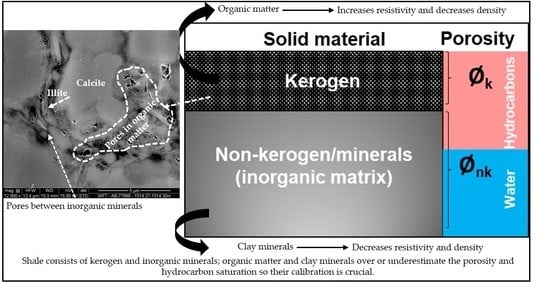Porosity and Water Saturation Estimation for Shale Reservoirs: An Example from Goldwyer Formation Shale, Canning Basin, Western Australia
Abstract
1. Introduction
2. Materials and Methods
2.1. Porosity Estimation
2.2. Calculation of Water Saturation
3. Results and Discussion
4. Conclusions
Author Contributions
Funding
Acknowledgments
Conflicts of Interest
Nomenclature
| density porosity | |
| matrix density | |
| bulk density | |
| fluid density | |
| bulk density (g/cc) | |
| kerogen conversion factor | |
| kerogen density (g/cc). | |
| grain density | |
| kerogen corrected bulk density | |
| porosity | |
| kerogen porosity | |
| total density porosity | |
| tortuosity factor | |
| Cc | convertible carbon fraction |
| total conductivity | |
| formation water conductivity | |
| HIp | present hydrogen index |
| HIo | original hydrogen index |
| m | cementation exponent |
| n | saturation exponent |
| PIp | present production index |
| PIo | original production index |
| formation water resistivity | |
| resistivity of shale | |
| true resistivity in ohm-m | |
| the rock resistivity in lean shale interval where water saturation is deemed 100% | |
| Rk | Kerogen resistivity |
| water saturation | |
| TOC | total organic carbon content |
| TOCo | original total organic carbon |
| TR | transformation ratio |
| kerogen volume in fractions | |
| volume of shale |
References
- Jenner, S.; Lamadrid, A.J. Shale gas vs. coal: Policy implications from environmental impact comparisons of shale gas, conventional gas, and coal on air, water, and land in the United States. Energy Policy 2013, 53, 442–453. [Google Scholar] [CrossRef]
- Rezaee, R. Fundamentals of Gas Shale Reservoirs; John Wiley & Sons: Hoboken, NJ, USA, 2015. [Google Scholar]
- Ross, D.J.K.; Bustin, R.M. The importance of shale composition and pore structure upon gas storage potential of shale gas reservoirs. Mar. Pet. Geol. 2009, 26, 916–927. [Google Scholar] [CrossRef]
- Kadkhodaie, A.; Rezaee, R. A new correlation for water saturation calculation in gas shale reservoirs based on compensation of kerogen-clay conductivity. J. Pet. Sci. Eng. 2016, 146, 932–939. [Google Scholar] [CrossRef]
- Yu, H.; Wang, Z.; Rezaee, R.; Zhang, Y.; Han, T.; Arif, M.; Johnson, L. Porosity estimation in kerogen-bearing shale gas reservoirs. J. Nat. Gas Sci. Eng. 2018, 52, 575–581. [Google Scholar] [CrossRef]
- Walls, J.D.; Sinclair, S.W. Eagle Ford shale reservoir properties from digital rock physics. First Break 2011, 29. [Google Scholar] [CrossRef]
- Sondergeld, C.H.; Newsham, K.E.; Comisky, J.T.; Rice, M.C.; Rai, C.S. Petrophysical Considerations in Evaluating and Producing Shale Gas Resources. In Proceedings of the SPE Unconventional Gas Conference, Society of Petroleum Engineers, Pittsburgh, PA, USA, 23–25 February 2010; p. 34. [Google Scholar]
- Kale, S.; Rai, C.; Sondergeld, C. Rock Typing in Gas Shales. In Proceedings of the SPE Annual Technical Conference and Exhibition, Society of Petroleum Engineers, Florence, Italy, 19–22 September 2010; p. 20. [Google Scholar]
- Ambrose, R.J.; Hartman, R.C.; Diaz-Campos, M.; Akkutlu, I.Y.; Sondergeld, C.H. Shale gas-in-place calculations part I: New pore-scale considerations. Spe J. 2012, 17, 219–229. [Google Scholar] [CrossRef]
- Yu, H.; Rezaee, R.; Wang, Z.; Han, T.; Zhang, Y.; Arif, M.; Johnson, L. A new method for TOC estimation in tight shale gas reservoirs. Int. J. Coal Geol. 2017, 179, 269–277. [Google Scholar] [CrossRef]
- Jacobi, D.J.; Breig, J.J.; LeCompte, B.; Kopal, M.; Hursan, G.; Mendez, F.E.; Bliven, S.; Longo, J. Effective geochemical and geomechanical characterization of shale gas reservoirs from the wellbore environment: Caney and the Woodford shale. In Proceedings of the SPE Annual Technical Conference and Exhibition, Society of Petroleum Engineers, New Orleans, LA, USA, 4–7 October 2009. [Google Scholar]
- Fu, Q.; Horvath, S.C.; Potter, E.C.; Roberts, F.; Tinker, S.W.; Ikonnikova, S.; Fisher, W.L.; Yan, J. Log-derived thickness and porosity of the Barnett Shale, Fort Worth basin, Texas: Implications for assessment of gas shale resources. Aapg Bull. 2015, 99, 119–141. [Google Scholar] [CrossRef]
- Arredondo-Ramírez, K.; Ponce-Ortega, J.M.; El-Halwagi, M.M. Optimal planning and infrastructure development for shale gas production. Energy Convers. Manag. 2016, 119, 91–100. [Google Scholar] [CrossRef]
- Yuan, Y.; Rezaee, R.; Al-Khdheeawi, E.A.; Hu, S.-Y.; Verrall, M.; Zou, J.; Liu, K. Impact of Composition on Pore Structure Properties in Shale: Implications for Micro-/Mesopore Volume and Surface Area Prediction. Energy Fuels 2019, 33, 9619–9628. [Google Scholar] [CrossRef]
- Yuan, Y.; Rezaee, R.; Verrall, M.; Hu, S.-Y.; Zou, J.; Testmanti, N. Pore characterization and clay bound water assessment in shale with a combination of NMR and low-pressure nitrogen gas adsorption. Int. J. Coal Geol. 2018, 194, 11–21. [Google Scholar] [CrossRef]
- Labani, M.M.; Rezaee, R.; Saeedi, A.; Al Hinai, A. Evaluation of pore size spectrum of gas shale reservoirs using low pressure nitrogen adsorption, gas expansion and mercury porosimetry: A case study from the Perth and Canning Basins, Western Australia. J. Pet. Sci. Eng. 2013, 112, 7–16. [Google Scholar] [CrossRef]
- Archie, G.E. The electrical resistivity log as an aid in determining some reservoir characteristics. Trans. AIME 1942, 146, 54–62. [Google Scholar] [CrossRef]
- Simandoux, P. Dielectric measurements in porous media and application to shaly formation: Revue del’Institut Francais du Petrole. Suppl. Issue 1963, 18, 193–215. [Google Scholar]
- Wang, F.P.; Gale, J.F. Screening Criteria for Shale-Gas Systems. Gulf Coast Association of Geological Societies Transactions: Tulsa, OK, USA, 2009; Volume 59, pp. 779–793. [Google Scholar]
- Bust, V.K.; Majid, A.A.; Oletu, J.U.; Worthington, P.F. The petrophysics of shale gas reservoirs: Technical challenges and pragmatic solutions. Pet. Geosci. 2013, 19, 91–103. [Google Scholar] [CrossRef]
- Akbar, M.N.A.; Musu, J.T.; Milad, B. Water Saturation Interpretation Model for Organic-Rich Shale Reservoir: A Case Study of North Sumatra Basin. In Proceedings of the Unconventional Resources Technology Conference (URTEC), Houston, TX, USA, 23–25 July 2018. [Google Scholar]
- Haines, P. Depositional Facies and Regional Correlations of the Ordovician Goldwyer and Nita Formations, Canning Basin, Western Australia, with Implications for Petroleum Exploration; Geological Survey of Western Australia, Record: East Perth, WA, Australia, 2004; p. 7. [Google Scholar]
- Johnson, L.M.; Rezaee, R.; Kadkhodaie, A.; Smith, G.; Yu, H. Geochemical property modelling of a potential shale reservoir in the Canning Basin (Western Australia), using Artificial Neural Networks and geostatistical tools. Comput. Geosci. 2018, 120, 73–81. [Google Scholar] [CrossRef]
- Johnson, L.M. Integrated Reservoir Characterization of the Goldwyer Formation, Canning Basin; Curtin University, Perth, Western Australia, 2019.
- Tissot, B.P.; Welte, D.H. Diagenesis, Catagenesis and Metagenesis of Organic Matter, in Petroleum Formation and Occurrence; Springer: Berlin/Heidelberg, Germany, 1984; pp. 69–73. [Google Scholar]
- Espitalie, J.; Madec, M.; Tissot, B.; Mennig, J.; Leplat, P. Source rock characterization method for petroleum exploration. In Proceedings of the Offshore Technology Conference, Houston, TX, USA, 2–5 May 1977. [Google Scholar]
- Passey, Q.; Creaney, S.; Kulla, J.; Moretti, F.; Stroud, J. A practical model for organic richness from porosity and resistivity logs. Aapg Bull. 1990, 74, 1777–1794. [Google Scholar]
- Peters, K.E.; Walters, C.; Moldowan, J.M. Biomarkers and Isotopes in the Environment and Human History; Cambridge University Press: Cambridge, UK, 2005. [Google Scholar]
- Kilgore, E.; Land, A.; Schmidt, A.; Yunker, J. Applications of the Coriband Technique to Complex Lithologies. Log Anal. 1972, 13, 24. [Google Scholar]
- Johnson, L.M.; Rezaee, R.; Smith, G.C.; Mahlstedt, N.; Edwards, D.S.; Kadkhodaie, A.; Yu, H. Kinetics of hydrocarbon generation from the marine Ordovician Goldwyer Formation, Canning Basin, Western Australia. Int. J. Coal Geol. 2020, 232, 103623. [Google Scholar] [CrossRef]
- Leveaux, J.; Poupon, A. Evaluation of water saturation in shaly formations. Log Anal. 1971, 12, 6. [Google Scholar]
- Clavier, C.; Coates, G.; Dumanoir, J. Theoretical and Experimental Bases forthe Dual-Water Model for the Interpretation of Shaly Sands. Soc. Pet. Eng. J. 1984, 24, 153–167. [Google Scholar] [CrossRef]
- Chalmers, G.R.; Bustin, R.M.; Power, I.M. Characterization of gas shale pore systems by porosimetry, pycnometry, surface area, and field emission scanning electron microscopy/transmission electron microscopy image analyses: Examples from the Barnett, Woodford, Haynesville, Marcellus, and Doig units. Aapg Bull. 2012, 96, 1099–1119. [Google Scholar]
- Wu, T.; Li, X.; Zhao, J.; Zhang, D. Multiscale pore structure and its effect on gas transport in organic-rich shale. Water Resour. Res. 2017, 53, 5438–5450. [Google Scholar] [CrossRef]
- Wei, W.; Zhu, X.; Meng, Y.; Xiao, L.; Xue, M.; Wang, J. Porosity model and its application in tight gas sandstone reservoir in the southern part of West Depression, Liaohe Basin, China. J. Pet. Sci. Eng. 2016, 141, 24–37. [Google Scholar] [CrossRef]
- Mastalerz, M.; Schimmelmann, A.; Drobniak, A.; Chen, Y. Porosity of Devonian and Mississippian New Albany Shale across a maturation gradient: Insights from organic petrology, gas adsorption, and mercury intrusion. Aapg Bull. 2013, 97, 1621–1643. [Google Scholar] [CrossRef]
- Tian, H.; Wang, M.; Liu, S.; Zhang, S.; Zou, C. Influence of Pore Water on the Gas Storage of Organic-Rich Shale. Energy Fuels 2020, 34, 5293–5306. [Google Scholar] [CrossRef]
- Cao, T.; Xu, H.; Liu, G.; Deng, M.; Cao, Q.; Yu, Y. Factors influencing microstructure and porosity in shales of the Wufeng-Longmaxi formations in northwestern Guizhou, China. J. Pet. Sci. Eng. 2020, 191, 107181. [Google Scholar] [CrossRef]

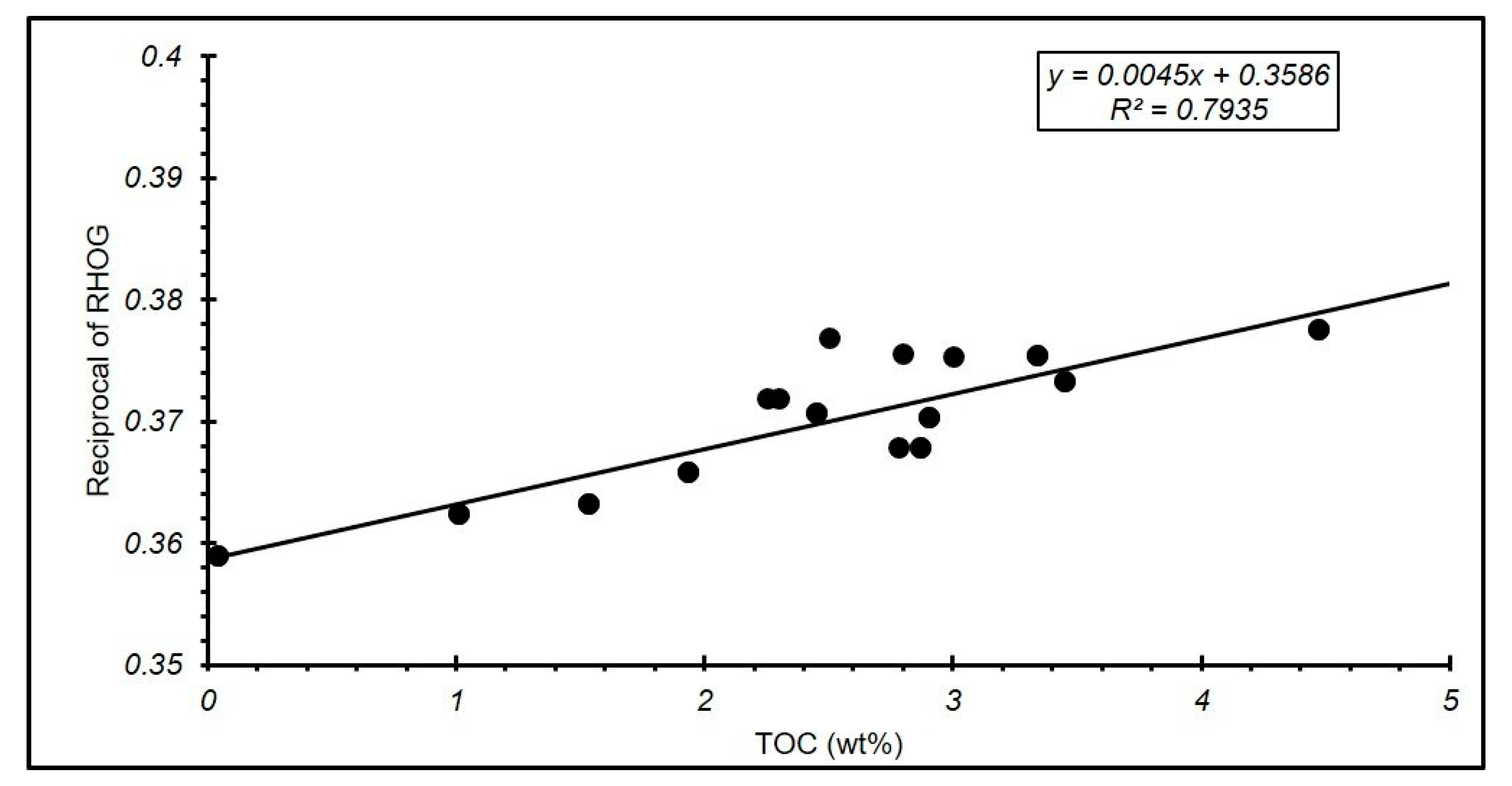
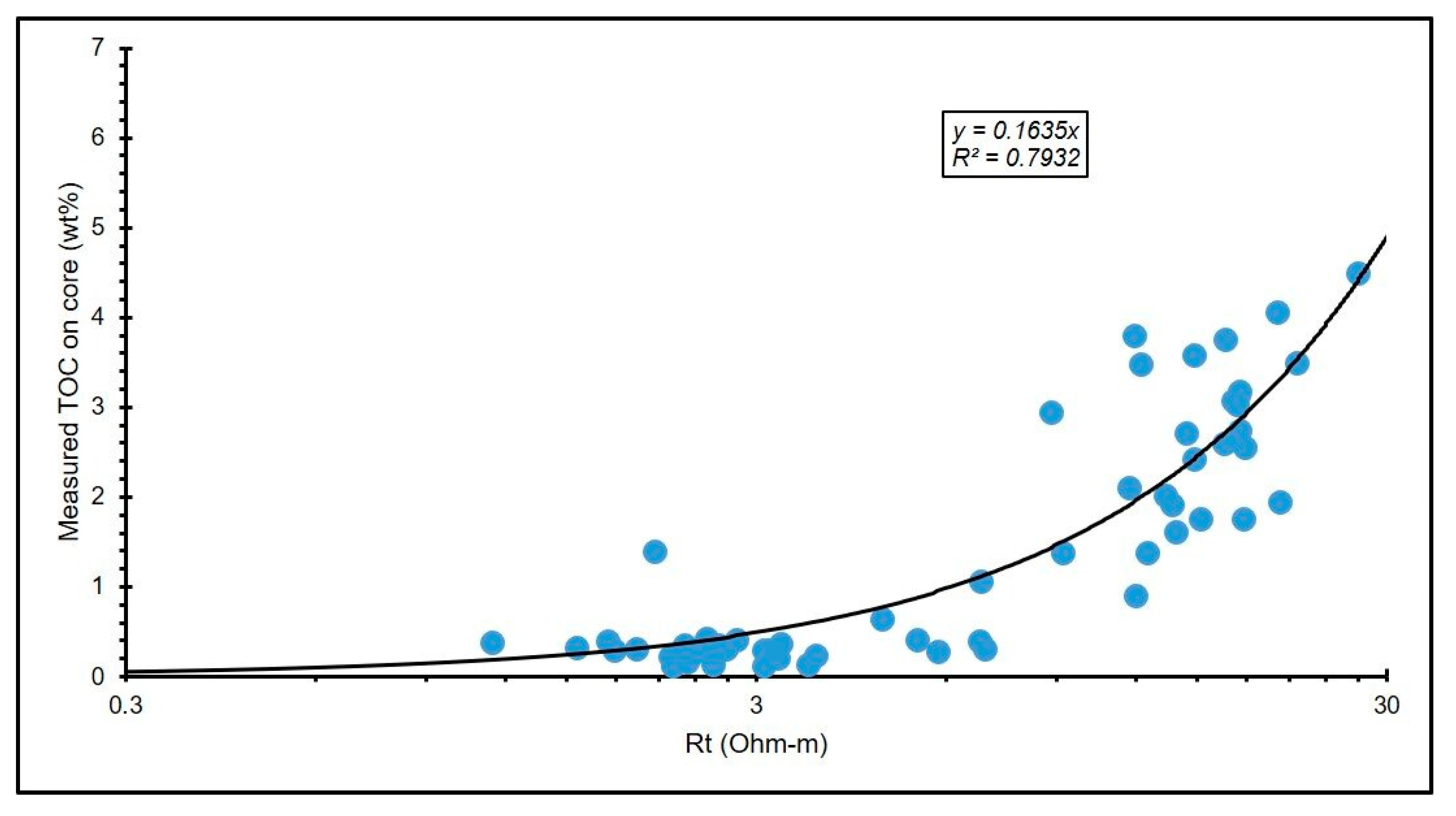
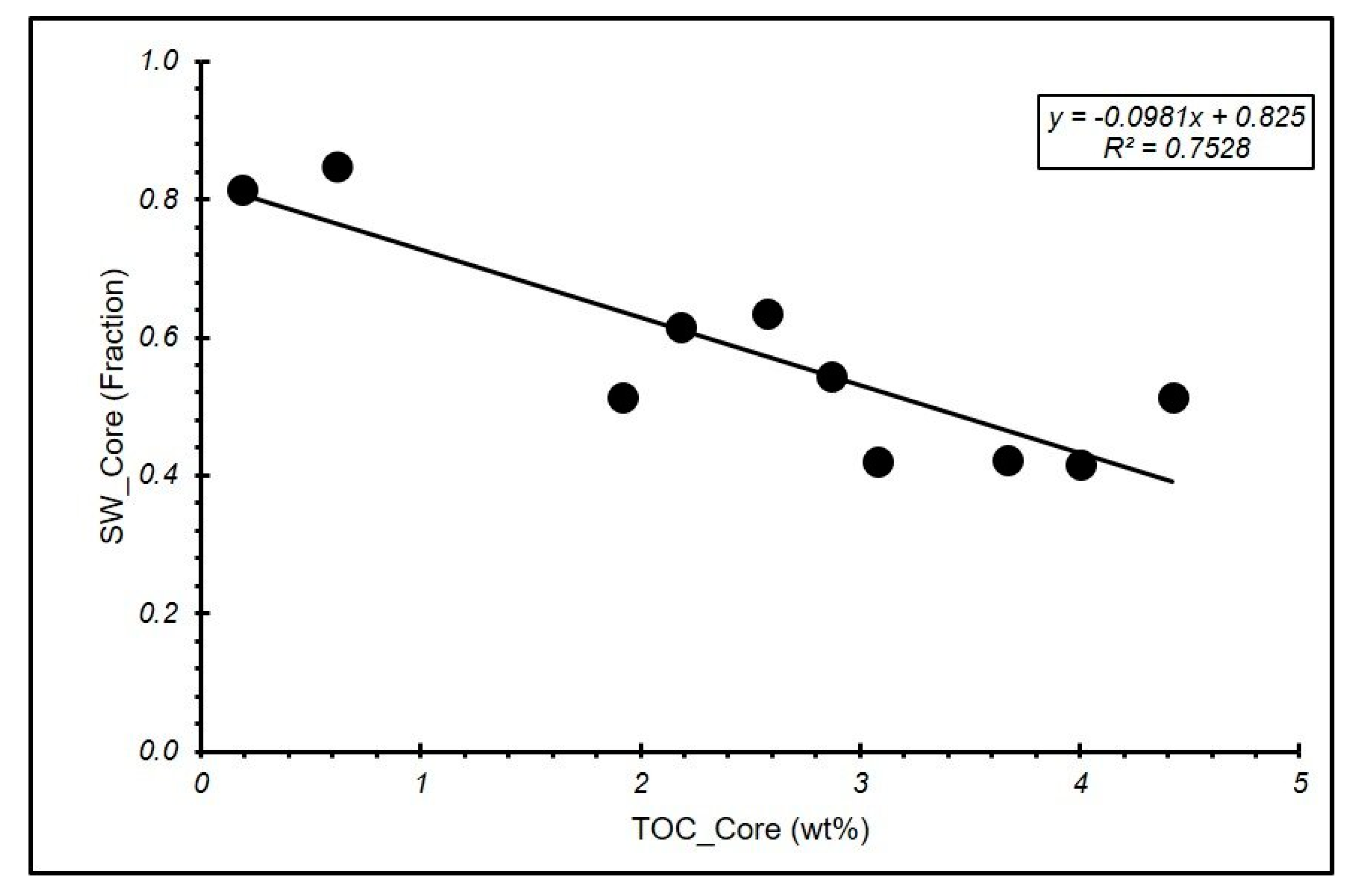
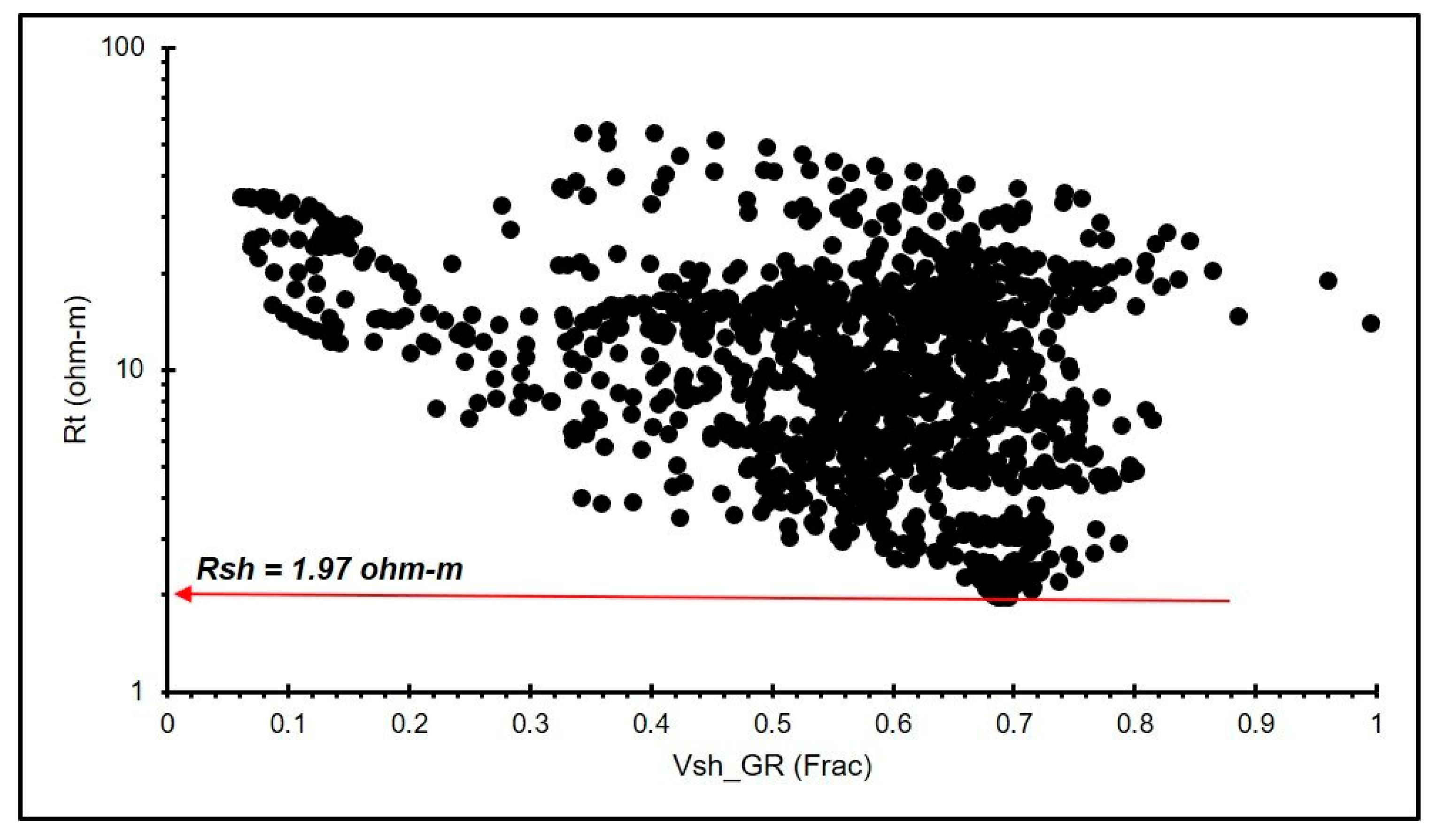

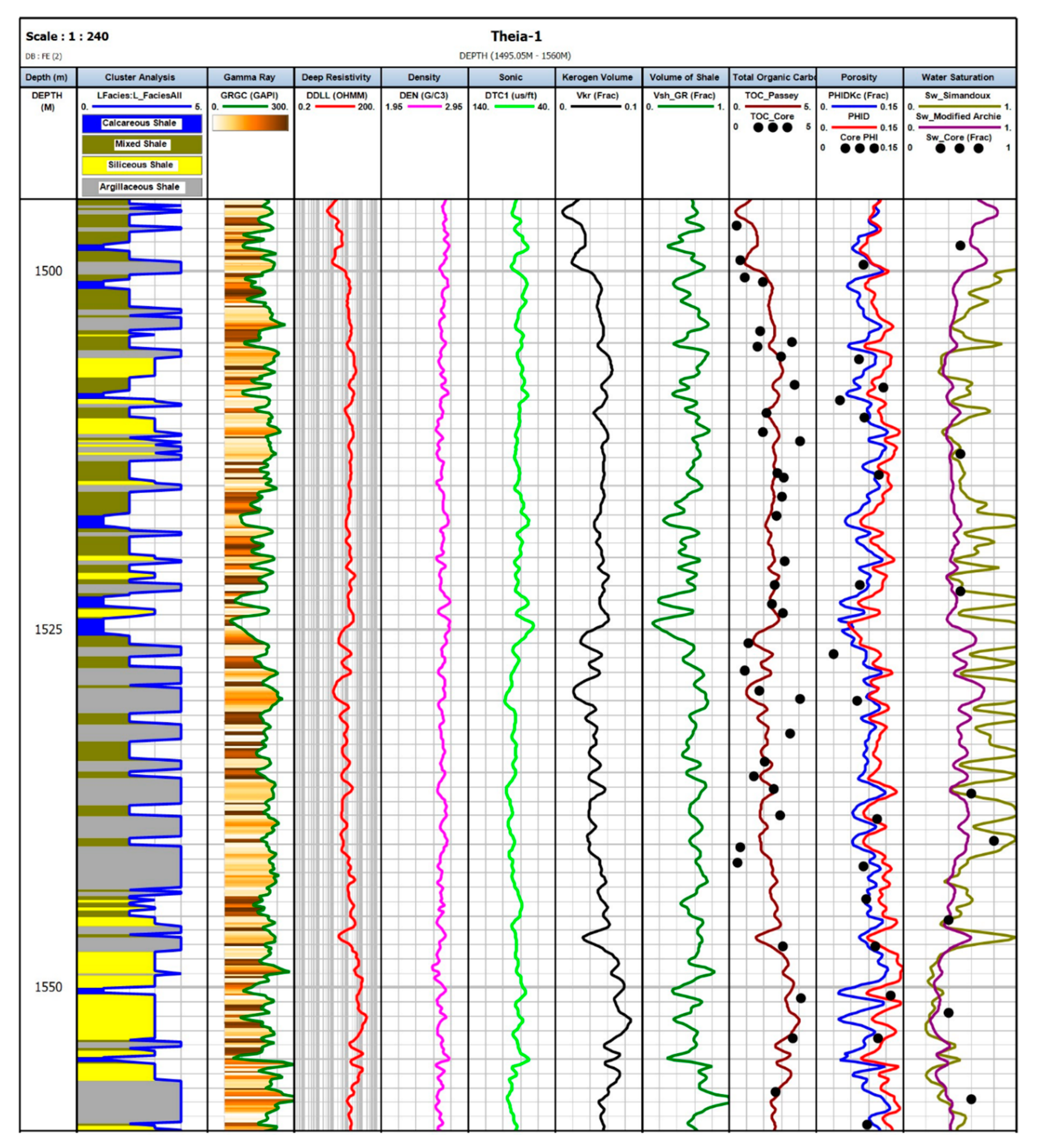
| Stage | Type of Kerogen | ||
|---|---|---|---|
| I | II | III | |
| Diagenesis | 1.25 | 1.34 | 1.48 |
| End of Catagenesis | 1.20 | 1.19 | 1.18 |
| Cluster | Lithofacies | TOC | PHIDKc | Sw_Modified Archie | PHID | Sw_Simandoux |
|---|---|---|---|---|---|---|
| (wt. %) | % | % | % | % | ||
| Cluster-1 (Blue) | Calcareous shale | 0.7 | 5 | 55 | 6 | 90 |
| Cluster-2 (Olive) | Mixed shale | 1.4 | 8.5 | 45 | 10 | 80 |
| Cluster-3 (Yellow) | Siliceous shale | 2.5 | 8 | 35 | 12 | 45 |
| Cluster-4 (Grey) | Argillaceous shale | 3.5 | 9 | 80 | 13 | >100 |
Publisher’s Note: MDPI stays neutral with regard to jurisdictional claims in published maps and institutional affiliations. |
© 2020 by the authors. Licensee MDPI, Basel, Switzerland. This article is an open access article distributed under the terms and conditions of the Creative Commons Attribution (CC BY) license (http://creativecommons.org/licenses/by/4.0/).
Share and Cite
Iqbal, M.A.; Rezaee, R. Porosity and Water Saturation Estimation for Shale Reservoirs: An Example from Goldwyer Formation Shale, Canning Basin, Western Australia. Energies 2020, 13, 6294. https://doi.org/10.3390/en13236294
Iqbal MA, Rezaee R. Porosity and Water Saturation Estimation for Shale Reservoirs: An Example from Goldwyer Formation Shale, Canning Basin, Western Australia. Energies. 2020; 13(23):6294. https://doi.org/10.3390/en13236294
Chicago/Turabian StyleIqbal, Muhammad Atif, and Reza Rezaee. 2020. "Porosity and Water Saturation Estimation for Shale Reservoirs: An Example from Goldwyer Formation Shale, Canning Basin, Western Australia" Energies 13, no. 23: 6294. https://doi.org/10.3390/en13236294
APA StyleIqbal, M. A., & Rezaee, R. (2020). Porosity and Water Saturation Estimation for Shale Reservoirs: An Example from Goldwyer Formation Shale, Canning Basin, Western Australia. Energies, 13(23), 6294. https://doi.org/10.3390/en13236294





